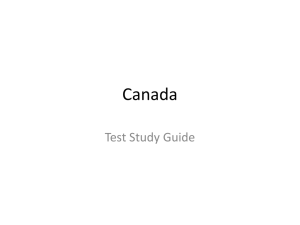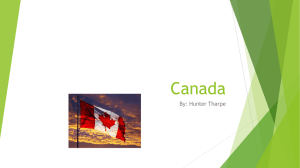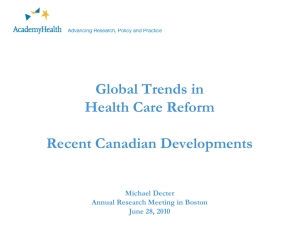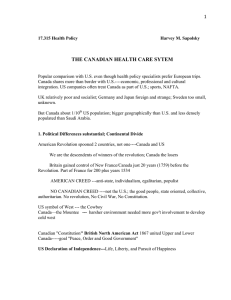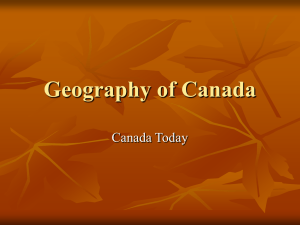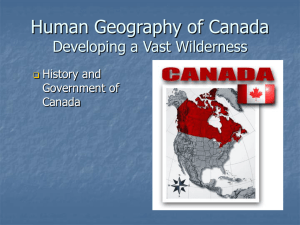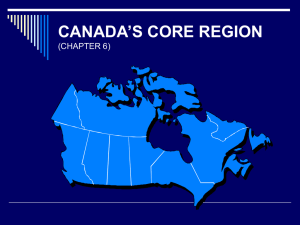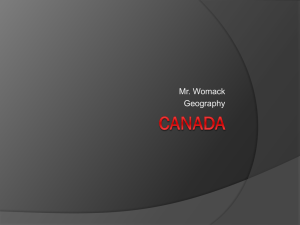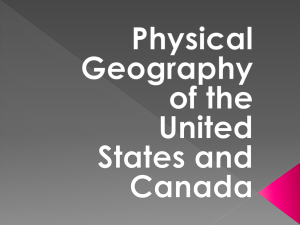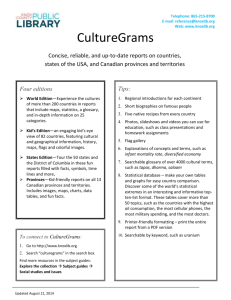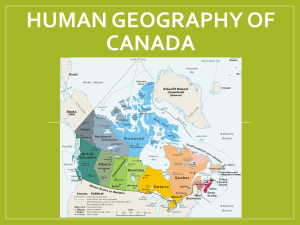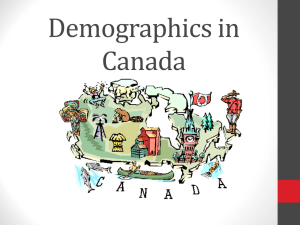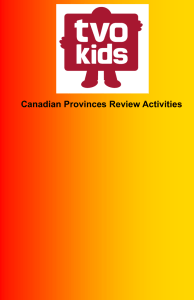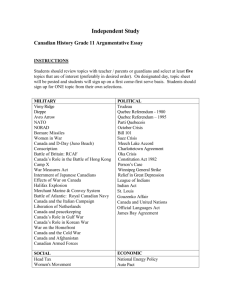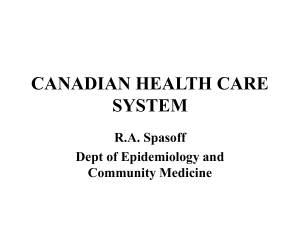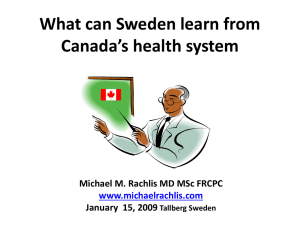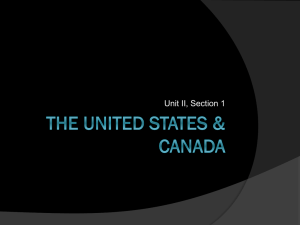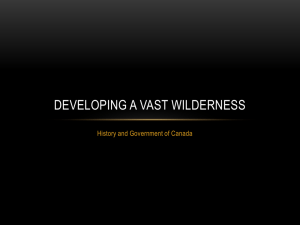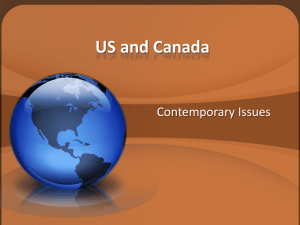Chapter 4
advertisement
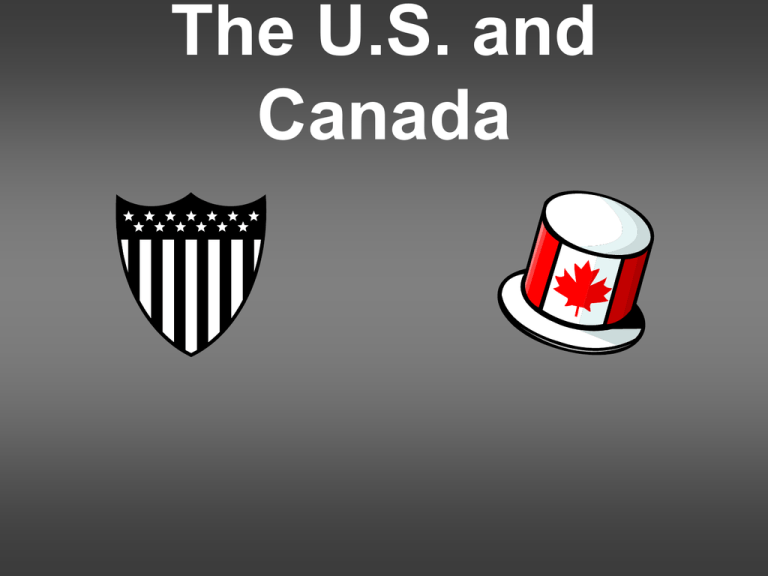
The U.S. and Canada Toronto, Ontario Montreal: Confluence of the St. Lawrence/Ottawa Rivers Ottawa: Canada’s Federal Capital located on the Ottawa River. Canadian Parliament (Legislature) Washington, D.C. The U.S. Federal Capital. The Senate and the House Chicago, Illinois Chicago: on the shores of Lake Michigan The Chicago river runs through town New York: The Big Apple Wall St. the center of the Financial World. The Bulls and the Bears What’s happening? Traders in the Pit. Los Angeles, California Los Angeles: Harbor Los Angeles: Sunny Days at the beach. Houston,Texas: We built this city on oil and cattle $. San Francisco, California The Golden Gate Bridge Independence Hall Philadelphia, Pa. Constitution was drafted St. Louis Gateway Arch At the confluence of the Mississippi and Missouri rivers. Wheat fields of the mid-west. Americas breadbasket. Influence of the Automobile: Drive-through service. Influence of the Automobile: Interstates. And more being built throughout the nation every year. The United States is a multi-cultural society Chinatown in San Francisco Chinatown: A Bank Fortune Cookie Factory French Quarter in New Orleans, La. Bourbon St. Export of U.S. Culture Chapter 5 Physical Geography of The United States & Canada • Rocky Mountains – The other major mountain range in the U.S. & Canada. It extends 3,000 miles from Alaska to New Mexico. • Appalachian Mountains – One of the major mountain ranges in North America. Extends 1,600 miles from Newfoundland, Canada to Alabama • Canadian Shield – Covers 2 million miles in Canada around Hudson Bay • Fall Line – The place where the higher land of the Piedmont drops to the Lower Atlantic Coastal Plain *****(Richmond, VA) is on the Fall Line • The Great Lakes – Lake Huron, Ontario, Michigan, Erie and Superior. – Found in the northern part of the U.S. and the southern part of Canada • Continental Divide – The line of the highest points in the Rocky Mountains. Marks the difference between rivers that flow east and those that flow west. • Mackenzie River – Canada’s longest river. Flows across the Northwest Territories. • Great Plains – A treeless region in the central portion of the United States • Permafrost – Permanently frozen ground • Everglades – A huge swampland in Florida, that covers 4,000 square miles. • Nomads – People who move from place to place. • Beringia – A land bridge that once connected Siberia and Alaska. • St. Lawrence Seaway – North America’s most important deep water shipping route. • Locks – Sections of waterways with closed gates where water levels are raised and lowered. • New England – A northern subregion of the United States (includes Maine, Vermont, New Hampshire, Massachusetts, Rhode Island, Connecticut) • Midwest (America’s Heartland) – The 12 states in the North-Central United States. • South – The subregion that covers ¼ of the land area of the United States and contains more than 1/3 of it’s population • The West – A region of the U.S. that stretches from the Great Plains to the Pacific Ocean. Covers about ½ of the U.S. landmass and about 1/5 of it’s population. • Provinces – Are the political units in Canada. Like States in the U.S. • Atlantic Provinces – The four provinces in Eastern Canada (Prince Edward Island, New Brunswick, Nova Scotia, and Newfoundland.) • Core Provinces – Quebec and Ontario • Often called Canada’s Heartland—60% of Canadians live here. The center of Canadian Politics. Ontario is the center of English Canadian life and Quebec is the center of French Candian Life. • Prairie Provinces – Located to the West of Ontario and Quebec (Manitoba, Saskatchewan, and Alberta). The center of Canadian agriculture. • The Pacific Province and Territories – (British Columbia, Yukon Territory, Northwest Territories, & Nunavut) • British Columbia – Canada’s westernmost province, contains Vancouver (Canada’s largest port). • Nunavut – Formed in 1999 this is the home to much of Canada’s Inuit population. • Prevailing Westerlies – Winds that blow from West to East in the midlatitudes. Chapter 6 Cultural Geography of the United States & Canada • Columbian Exchange – The trade network that involved the exchange of goods between North America, Europe, Africa, and Asia • Louisiana Purchase – (1803) when the U.S. government purchased the area between the Mississippi and the Rocky Mountains from France. This doubled the size of the United States. • Frontier – The free-open land that was available for settlement in the late 1800’s. • Migration – Movement (of people within the U.S.) • Urbanization – The movement of people from rural areas to cities. • Suburbs – The communities directly outside of a city. • Metropolitan Area – The city and the suburbs around it. • Urban Sprawl – When cities spread outward as more and more suburbs are built. • Smart Growth – The efficient use and conservation of land and other resources. • Sustainable Communities – Communities where residents live and work in the same area. • Megalopolis – An area where multiple large cities grow together. • Representative Democracy – The people rule through elected representatives. • Dominion of Canada – (1867) was created by the British North America Act. United Upper Canada (Ontario) and Lower Canada (Quebec) in a confederation. • Confederation – A political Union made up of loosely connected provinces. • Parliamentary Government – A political system in which the Legislative and Executive branches are combined in a legislature called Parliament. • Prime Minister – The head of government in Canada (sort of like our President) • First Nations – Canada’s Native American Peoples. • Metis – People of mixed French and Native heritage. • Reserves – Public land set aside for the Native Peoples. Chapter 7 The Region Today • NAFTA (The North American Free Trade Agreement) – An agreement between the United States, Canada, and Mexico which has eliminated trade barriers between the countries • Export – The goods sold to another country. • Free Enterprise – Private individuals own most of the resources, technology, and businesses and operate with few government restrictions • Service Industry – Any kind of economic activity that produces a service rather than a product. • Postindustrial Economy – An economy where manufacturing no longer plays a major role. • Multinationals – American companies that participate in business worldwide. • The Rust Belt – The area east of The Great Lakes where businesses have moved and left behind rusting factories and steel mills • The Wheat Belt – The Prairie Provinces of Canada and the Great Plains of the U.S. where wheat is grown. • Terrorism – The threat or use of violence against individuals (or property) with the purpose of causing fear in an effort to reach a specific goal. • Global Network – A worldwide interconnected group. • Coalition – An alliance • Biological Weapons – Bacteria or viruses that can be used to kill (or harm) people, animals, or plants. THE END Bell Work 9/20 • Using your textbook (pg 159), in a short paragraph (at least 3 sentences) discuss health care in Canada. Bell Work 9/28 • Write a brief history of your family. Include where your ancestors immigrated from, and (if you know) why. Bell Work 9/24 • How has Terrorism effected your life?

